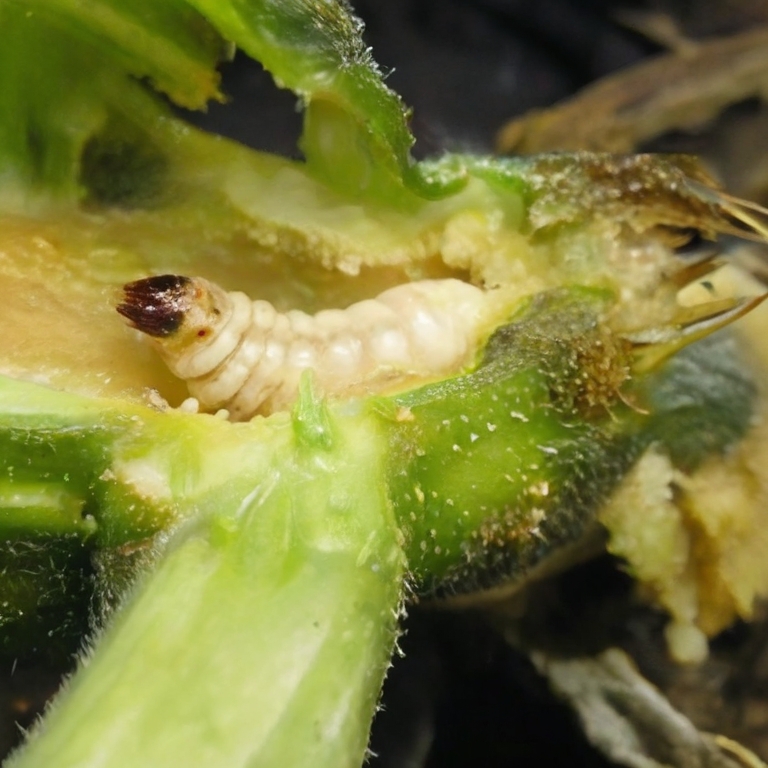Squash Vine Borer

Damage
Attack by squash vine borer is characterized by a sudden wilt of the plant. Larvae bore within stems, usually in the lower 30 cm (one foot) of the stem. When gourds are grown on a trellis, borers can be found at any stem node, even several feet above ground. Stems can be girdled by borers, which prevents water and nutrients from circulating in the plant. The point where a borer enters a stem is marked by a hole with yellow granular or sawdust-like frass exuding from it. Injured vines often decay and become wet and shiny. Infested plants can be weakened or they can die; the ultimate effect on the plant depends on the number of borers and their location. Over 100 larvae have been found in a single vining plant in plants with multiple stems, but one larva per plant is most common. If a plant wilts but there is no evidence of borers, other possible causes are a bacterial wilt infection, yellow vine disease, or root feeding by larval cucumber beetles.
Hosts
Squash, zucchini, pumpkins, and gourds are attacked. The borer prefers Hubbard squash over other hosts. Butternut squash is less susceptible than other squashes. Cucumbers and melons are usually not attacked.

Appearance
Eggs are oval, flattened, dull-red in color, and 1 mm (1/25 inch) in diameter. The larva is a fat grub-like caterpillar with a white, wrinkled body and a brown head. A fully grown larva is 25 mm (1 inch) long. The pupa is brown and 16 mm (5/8 inch) long, and contained inside a cocoon made of earth-covered black silk and is 19 mm (3/4 inch) long.
The adult is a moth that looks somewhat like a wasp; the body is black, marked with orange-ish red and the hind legs are feathery with black and orange hairs. The front wings are metallic green and the hind wings are transparent; the wingspan is 25 to 37 mm (1 to 1.5 inch). Male and female moths are similar, although the male is more colorful, smaller, has a narrower abdomen, and featherier antennae.
Life Cycle and Behavior
The squash vine borer overwinters as a fully grown larva in a cocoon in the soil, 2 to 15 cm (1 to 6 inches) deep. It pupates in the spring and the adult, a moth, emerges in June. Squash vine borer moths are active during the daytime and in the evening they rest on leaves. This is different than the behavior of most moth species, which are active at night. The squash vine borer moths fly slowly in zig-zags around plants,
Natural Enemies
The stage most susceptible to natural enemies is the egg stage, which is attacked by parasitic wasps. Larval and adult ground beetles (family Carabidae) can attack larvae of squash vine borer, but do not appear to cause significant mortality.
Cultural Control
-
Destroy vines soon after harvest to destroy any larvae still inside stems.
-
Disk or plow the soil in fall or spring to destroy overwintering cocoons.
-
Cover vines at leaf joints with moist soil, to promote formation of secondary roots that will support the plant if the main root and stem are injured.
-
A trap crop of very early-planted Hubbard squash can be used to alleviate pest pressure from other cucurbits.
Physical Control
The following are suitable in small plantings:
-
Borers can be removed from vines if detected before much damage is done. Examine stems in early summer; once holes are detected, slit the stem longitudinally with a fine sharp knife, remove the borer, then cover the wounded stem with moist soil above the point of injury to promote additional root formation.
-
Stems can be covered with a barrier, such as strips of nylon stockings, to prevent egg laying.
-
Catch and destroy the moths, especially at twilight or in early morning when they are resting on the upper side of leaf bases.
-
Hand-pick the eggs before they hatch.
Chemical Control
Squash vine borer can be killed by chemicals but the trick is in the timing of the application. An insecticide is effective when applied at the time that eggs are hatching. A preventive treatment regime is to apply an insecticide when vines begin to run, and re-apply every 7 to 10 days for 3 to 5 weeks. The application should be directed to the base of plants, at crowns and runners.
Chemicals used for borer control in gardens are methoxychlor, rotenone, pyrethru m, malathion, or carbaryl (Sevin), applied as sprays or dusts.
Source: OSU Ext.,Celeste Welty
